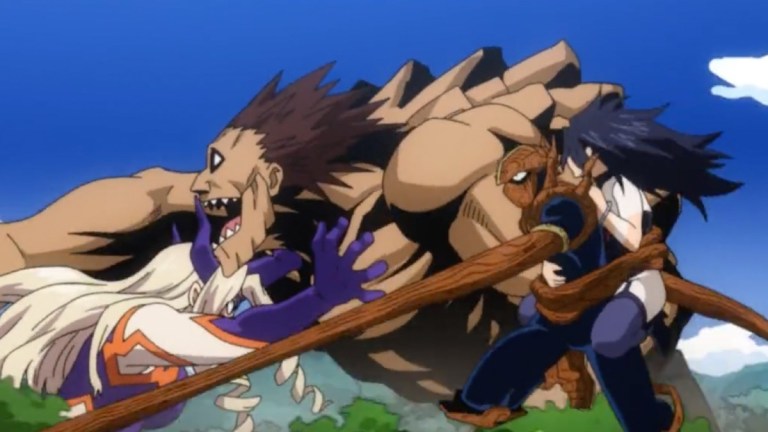My Hero Academia Season 6 Episode 7 Enlists Deku and Bakugo
Teamwork truly makes the dream work as Endeavor and Eraser Head gain some unexpected support in their fight against Shigaraki.

This My Hero Academia review contains spoilers.
My Hero Academia Season 6 Episode 7
“If we couldn’t defeat him, the age of heroes would be a joke.”
The Paranormal Liberation Front and the Pro Heroes are currently locked in combat, but it’s only the latter who need to worry about their reputations. Shigaraki and his minions are reckless agents of chaos who are destined to reshape society, but the public doesn’t expect anything from them. Alternatively, the Pro Heroes are in a tacit agreement with the public where they’re entrusted to right wrongs and save the city if it’s in the throes of decay. “Disaster Walker” puts the pressure on the heroes and, as the above quote encapsulates, if they can’t pull off this takedown on Shigaraki then none of their work has ever really mattered. In My Hero Academia’s “Disaster Walker” it’s time to rise to the occasion and truly embody heroism when society needs it the most.
“Disaster Walker” builds upon the momentum of last week’s fiery installment so that the action here is at the peak of its game and some of the best combat to ever appear in My Hero Academia. Endeavor’s feud with Shigaraki continues to heat up and the Number One Pro Hero turns to last resort attacks like Hell Spider. The skies are ablaze with Endeavor’s heroism, but this becomes a humbling exercise after Endeavor’s tactics continually fall short. It’s some real Frieza-level arrogance when Shigaraki outright stands on Endeavor’s chest to hammer in his superiority.
The Endeavor and Shigaraki showdown matures into some of My Hero Academia’s most impressive animation. There are dazzling visuals and sublime choreography once this one-on-one battle turns into a hero tag team attack. Shigaraki may have All For One’s many Quirks and infinite rage, but in this moment he understands the true weight of teamwork and how it’s a superpower that he may never have. In fact, he’s forced to continually fight off All For One’s parasitic attempts at possession. Every villain recognizes Shigaraki as the voice of the future. However, his vision to surpass All For One as the ultimate Symbol of Evil is a single-minded goal. Somewhere, at some point, Shigaraki’s growing hubris will become his undoing, but for now he reigns supreme.
Shigaraki has acolytes, not friends, which also translates into a slew of dinosaur-like Nomu that he wields as a blunt weapon. It’s a little convenient that the Nomu are back in business even though Garaki’s research facility is destroyed. However, this becomes another intimidating display of both the level of power and control that Shigaraki holds over his primary Decay Quirk. His mastery of his abilities is so proficient that he prevents the lab’s greatest experiments from fully disintegrating. It’s a believable excuse that keeps Deku, Bakugo, and Gran Torino quite busy before they join the skirmish against Shigaraki.
The other major player in this improvised team battle is Shota Aizawa, who arguably becomes the MVP of “Disaster Walker.” Aizawa’s Quirk has always been a debilitating threat and its ability to neutralize Shigaraki naturally makes him the villain’s next target. There’s some smart, suspenseful combat that occurs where a domino effect of heroes show up to prove themselves and defend each other. This altruism is juxtaposed against Midoriya’s painful memories studying under Eraser Head, which makes this selfless display hit as hard as possible. “Disaster Walker” even briefly makes the audience consider that Aizawa or Gran Torino are about to meet their ends on the battlefield. There’s extreme catharsis that drains out of every character even if they’re all too busy with combat to take a second to acknowledge it.
My Hero Academia’s “Disaster Walker” title could easily apply to Shigaraki or his Nomu servants, but it’s actually in reference to the awakened Gigantomachia. My Hero Academia has struggled with Gigantomachia in the past purely because he’s such a kaiju-esque terror who becomes difficult to adequately counter. Gigantomachia finally gets to fight someone who’s his own size when Mt. Lady takes him on. It’s an electric, albeit brief, showdown between these two jumbo juggernauts.
Mt. Lady’s dwindling endurance isn’t unique to her situation and the tide begins to turn for the heroes as more of them crumble under the villains’ power. Many students are thrust into action as they learn how to fight without the support and guidance of Pro Heroes and their teachers. It’s time for them to unofficially ascend into the big leagues. Former labels are erased and characters drop all pretenses as they pass the torch onto the next generation, like Midnight to Yaoyorozu, to conquer these intensely united villains. Any affront to Shigaraki is seen as a disgrace to the world’s “new liberator.” It’s literally all or nothing for the villains when it comes to Shigaraki, which is terrifying, but admirable.
All of the fear and doubt that grows out of this chaos also helps “Disaster Walker” emphasize who else will experience substantial losses as the Paranormal Liberation War begins to intensify. The heroes in the line of fire have all actively chosen this lifestyle, yet “Disaster Walker” extends a deeper look at the family members and innocent civilians, like Deku’s mom and Shoto’s siblings, who are set to lose just as much if Shigaraki’s plan comes to fruition. There’s even an adorable glimpse of All Might on babysitting duty with Eri. These are helpful reminders of what’s at stake if the heroes can’t transform this uncertainty into victory.
“Disaster Walker” is My Hero Academia at its best and a satisfying case of when character development culminates in excessive combat. The past few episodes haven’t disappointed when it comes to action sequences, but the current assault on Shigaraki trumps these previous spectacles. The character continues to gain depth and becomes frightening in new ways despite the relatively standstill nature of the plot. “Disaster Walker” proves that this level of sustained conflict can be successful. The episode concludes with even more players involved than when this crowded war began. However, these concentrated attacks provide clarity rather than clutter as characters prepare for the next stage of battle.
